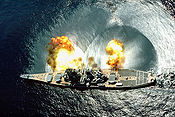
Broadside
Encyclopedia

Ship
Since the end of the age of sail a ship has been any large buoyant marine vessel. Ships are generally distinguished from boats based on size and cargo or passenger capacity. Ships are used on lakes, seas, and rivers for a variety of activities, such as the transport of people or goods, fishing,...
; the battery
Artillery battery
In military organizations, an artillery battery is a unit of guns, mortars, rockets or missiles so grouped in order to facilitate better battlefield communication and command and control, as well as to provide dispersion for its constituent gunnery crews and their systems...
of cannon
Cannon
A cannon is any piece of artillery that uses gunpowder or other usually explosive-based propellents to launch a projectile. Cannon vary in caliber, range, mobility, rate of fire, angle of fire, and firepower; different forms of cannon combine and balance these attributes in varying degrees,...
on one side of a warship
Warship
A warship is a ship that is built and primarily intended for combat. Warships are usually built in a completely different way from merchant ships. As well as being armed, warships are designed to withstand damage and are usually faster and more maneuvrable than merchant ships...
; or their simultaneous (or near simultaneous) fire in naval warfare
Naval warfare
Naval warfare is combat in and on seas, oceans, or any other major bodies of water such as large lakes and wide rivers.-History:Mankind has fought battles on the sea for more than 3,000 years. Land warfare would seem, initially, to be irrelevant and entirely removed from warfare on the open ocean,...
.
Age of Sail
In the Age of SailAge of Sail
The Age of Sail was the period in which international trade and naval warfare were dominated by sailing ships, lasting from the 16th to the mid 19th century...
(and in the early years of steam
Steam engine
A steam engine is a heat engine that performs mechanical work using steam as its working fluid.Steam engines are external combustion engines, where the working fluid is separate from the combustion products. Non-combustion heat sources such as solar power, nuclear power or geothermal energy may be...
) ships had long rows of guns set in each side of the hull
Hull (watercraft)
A hull is the watertight body of a ship or boat. Above the hull is the superstructure and/or deckhouse, where present. The line where the hull meets the water surface is called the waterline.The structure of the hull varies depending on the vessel type...
which could only fire to the one side: firing all guns on one side of the ship was known as a "broadside"; firing all guns on both sides was a double broadside. The cannons of 18th century men of war were accurate only at short range, and their penetrating power mediocre, entailing that thick hulls of wooden ships could only be pierced at short ranges. These wooden ships sailed closer and closer towards each other until cannon fire would be effective. Each tried to be the first to fire a broadside, often giving one party a decisive headstart in the battle when it crippled the other ship.
As a measurement

Fire power
Firepower is the military capability to direct force at an enemy. It is not to be confused with the concept of rate of fire, which describes cycling of the firing mechanism in a weapon system. It involves the whole range of potential weapons...
which can be delivered upon a single target, because this concentration is usually obtained by firing a broadside. This is calculated by multiplying the shell weight of the ship's main armament shells times the number of barrels that can be brought to bear. If some turrets are incapable of firing to either side of the vessel, only the maximum number of barrels which can fire to one side or the other are counted. For example, the American Iowa
USS Iowa (BB-61)
USS Iowa was the lead ship of her class of battleship and the fourth in the United States Navy to be named in honor of the 29th state...
-class battleship
Battleship
A battleship is a large armored warship with a main battery consisting of heavy caliber guns. Battleships were larger, better armed and armored than cruisers and destroyers. As the largest armed ships in a fleet, battleships were used to attain command of the sea and represented the apex of a...
s carry a main armament of nine 16 inches (40.6 cm) main guns in turrets which can all be trained to a single broadside. Each 16-inch shell weighs 2700 pounds (1,224.7 kg), which when multiplied by nine (the total number of barrels in all three turrets) equals a total of 24,300 pounds (11,022 kg). Thus, an Iowa-class battleship has a broadside of 12 short tons (11.0 tonnes), the weight of shells that she can theoretically land on a target in a single firing.
See list of broadsides of major World War II ships for a comparison.
Further reading
- George Dorsey, "When a U.S. Battleship Fires a Broadside," The New York Times Magazine, 30 December 1917.

